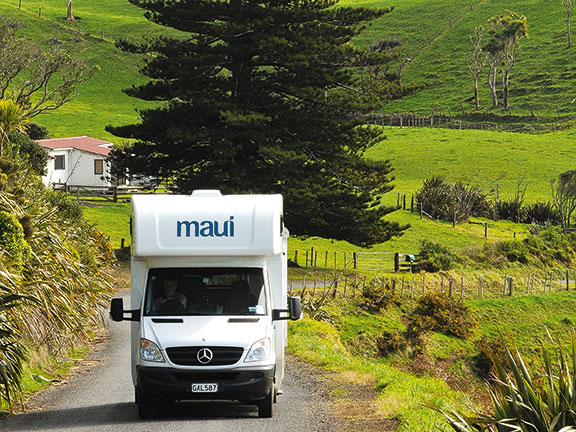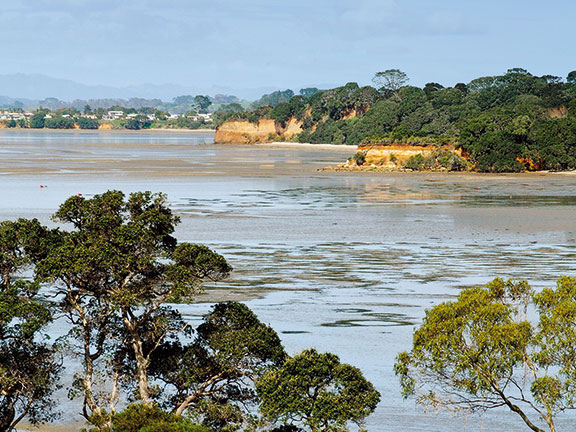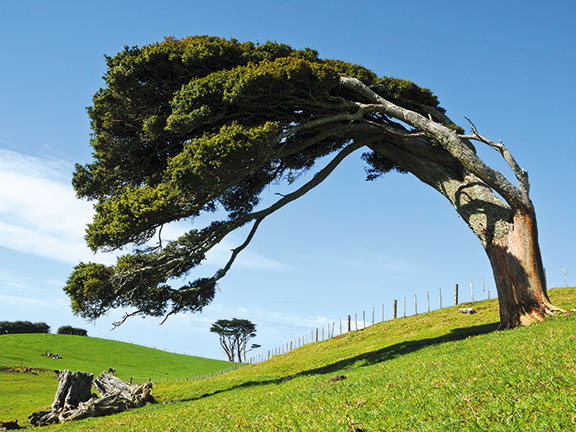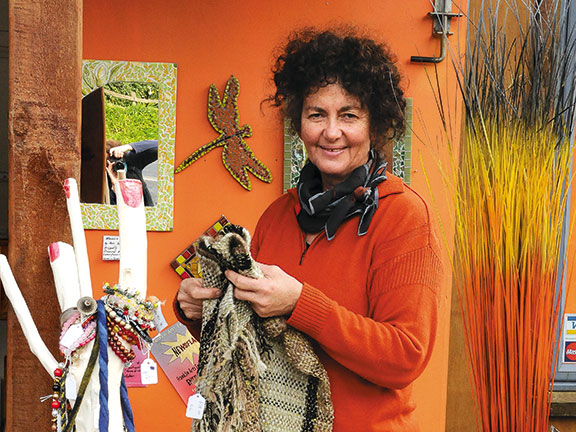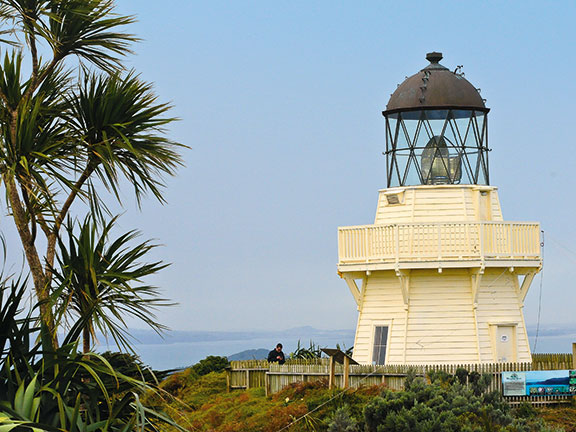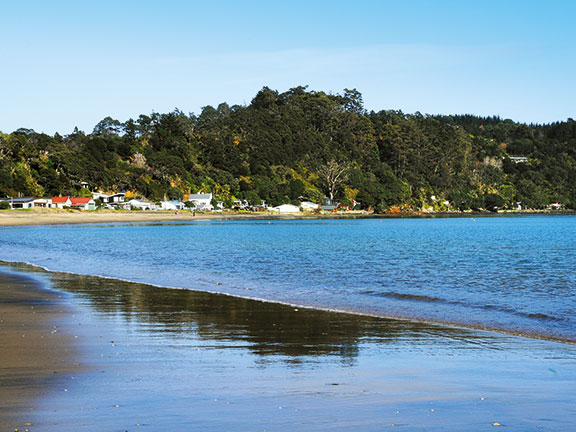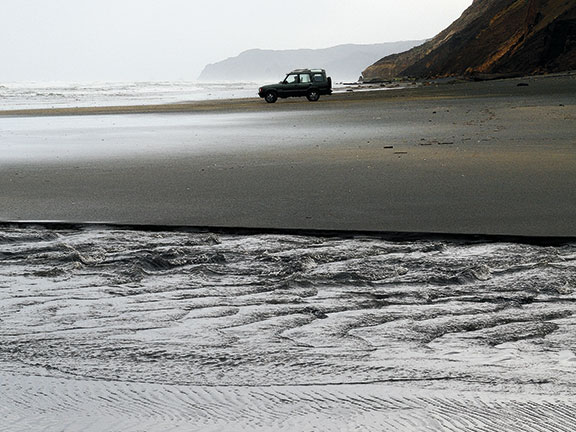Time and again, flying in or out of Auckland, I peer out of the plane windows at a green, crumpled, giant finger of land defining the western edge of Manukau Harbour. It's a big bird's view of small seaside bach communities, isolated farmsteads, roads wriggling along ridges and down into tight valleys with the Tasman coast, an arrow-straight dark sand strip, separating land from wild sea.
I explored the Awhitu Peninsula five years ago and am delighted to be back, but this time my hubby, Sam, and I are taking our bach with us in the form of a Maui motorhome. The number plate is GAL 587 so Gal becomes her name and, though plus-size at 7.2 metres long and 3.25 metres high, she has a 2.5-litre turbo Mercedes engine and Sam says she is a dream to drive.
The first stop, at the bottom of the peninsula, is Waiuku, a languidly spreading country town with hundred-year-old two-storey pubs and a fringe of weatherboard houses. Sam wants, and finds, a country pie. From here it's 30 kilometres as wood pigeons fly to the peninsula's tip but much further on jigsawed roads and, with stops, it takes most of the day.
Lush hills are peppered with udder-filled black and white cows. This is dairy territory, confirmed by crossing paths with a couple of Anchor tankers zooming south in silver flashes of stainless steel.
Half way up Awhitu, the village of Pollok is a knot of roads, a scatter of houses, church, hall, garage and the last fuel and supplies stop. The Gal has hardly used any diesel so we don't need to fill up but Sam checks out the last opportunity for another pie at Bhana's Foodmarket.
I explore Pollok Arts & Crafts Co-operative, home to a fine selection of jewellery, felted clothing, knitwear, paintings, photography, weaving and more. Country craft shops can be naff, but the quality of the products here is excellent and the prices are right. If the felted jacket I fell in love with had been one size bigger it would be mine.
The shop is adjoined by a sculpture garden, which is free to visit. Lois Templeton, the volunteer on duty, tells me motorhomers often stop for a picnic in the garden when heading up the peninsula; BYO food, but coffee (locally roasted) and tea are provided by the shop.
Beyond Pollok the hills become increasingly steep and we peer down to storybook valleys with lollypop trees, tiny houses and cows not much bigger than dots. In the west the Tasman Sea is steely grey and, as the coast is edged with cliffs, there is only one aptly-named road to it – West Coast Road. The Gal takes this skinny, partly sealed road in her stride and soon we are on the black sand beach watching the furious ocean thundering in from Australia. The layers of huge waves are mesmerising – a never-ending sequence of wild water – and Sam and I run around like a pair of children, daring ourselves to follow withdrawing waves and then running like crazy when the next big one zooms up the beach.
On the other side of the peninsula, just eight kilometres away, the ambience of Awhitu Regional Park couldn't be more different. Here baby waves can barely be bothered turning. The beach is white with shells that crunch underfoot and shore birds feast in the shallows. Giant pohutukawa stretch long limbs to touch high-tide water. It's sweet and pretty, feminine in contrast to the muscular wildness of the nearby Tasman Sea.
Across the Manukau Harbour the big birds come and go, gleaming in the sun, soundless and seemingly in slow motion, appearing and disappearing between patches of cloud. Beyond them the top of Rangitoto is a horizon smudge and the Sky Tower a cloud-piercing point.
A winery is not what we expected to find in this cow country, so Awhitu Wines, almost at the top of the peninsula, is a delightful surprise. Awhitu Wines is truly boutique. Only 4000 bottles of very fine wine are produced each year. Dave and Wendy Hendl, who own and live on the vineyard, do all the pruning and trimming and the grapes are hand-picked before being trucked to the wine maker.
First we try the syrah – peppery and rich with wild berry fruit. The chardonnay is light and lovely, slightly lemony and, thankfully, lacking the heavy-duty oak taste that usually puts me off chardonnay. The rain arrives while we are talking and tasting. We buy the last bottle of rosé.
The rain is relentless and the weatherman says there will be a lot more of it. The Gal takes us to Orua Bay Beach Motor Camp where we hook up to power. I snuggle up with a blanket and a book in the back, Sam immerses himself in sport on TV in the front and we share the bottle of rosé. Rainy nights, faraway places, fine wine and big motorhomes are a lot of fun.
The morning is clear blue, washed clean and sparkling. Orua Bay is a slice of heaven with children playing in the sand, couples strolling, a dog swimming to fetch a thrown stick, fishermen with long rods and far-flung hooks and gulls waiting for the tide to fall. There are 30 houses tucked between the beach and a bush-covered cliff and, on this still sunny morning, it's an enviable place to be. One cute beachside house is for sale. Dreams are free.
Sam points the Gal west and we follow increasingly curly roads to South Manukau Heads. The harbour-side gentleness soon disappears – the hills become tall and steep and dairy cows are replaced by hardy black cattle that tramp around almost vertical paddocks. I look down from high in the passenger seat and it's a horrible drop to the bottom of the valley. Sam and I look at each other. "Wouldn't want to roll the Gal," he says.
It's not just the hills that are rugged. On days that are less kind than this there must be staunch west winds because, on ridges, the trees swerve sideways, pointing towards Auckland.
The Manukau Heads Lighthouse is perched on a hilltop between the calm Manukau Harbour and the crazed Tasman Sea. It began work in 1874 – just slightly more than a decade after New Zealand's worst shipping disaster took place below when the Orpheus ran aground on the tidal bar in 1863 with the loss of 190 lives. The lighthouse was the first of its kind in New Zealand and the first to burn kerosene. In 1986 it was decommissioned and replaced by a modern signal station nearby. Restoration work is now complete and the original cast-iron lantern and massive crystal-glass lens remains neatly polished even though it is no longer winking across the sea to keep mariners safe. Visitors are welcome to climb the 120 steps to the top, from 9am daily.
From the foot of the lighthouse I look down at the Manukau bar and can't understand how anyone could consider navigating a boat through the muddle of wild waves churning into the distance. Away to the east I can see Auckland, with her million-plus people, basking in the sun. It's only 32 kilometres across the water, an hour and a half by road and a world away in ambience.
For the latest reviews, subscribe to our Motorhomes, Caravans & Destinations magazine here.

Wairarapa – what a ripper
Elisabeth Easther signed up for a six-day 300km cycle journey with Green Jersey Tours to ride their Remutaka, Palliser, Tora Tour, and declared the experience gold class.

